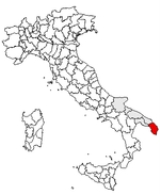
Taurisano
Encyclopedia
Taurisano is a town and comune
in the province of Lecce, in the Apulia
region of south-east Italy
.
, the population was 12,675. Nearby towns are Acquarica del Capo, Casarano, Ruffano and Ugento.
The town of Taurisano is the place of birth of the philosopher Giulio Cesare Vanini.
Comune
In Italy, the comune is the basic administrative division, and may be properly approximated in casual speech by the English word township or municipality.-Importance and function:...
in the province of Lecce, in the Apulia
Apulia
Apulia is a region in Southern Italy bordering the Adriatic Sea in the east, the Ionian Sea to the southeast, and the Strait of Òtranto and Gulf of Taranto in the south. Its most southern portion, known as Salento peninsula, forms a high heel on the "boot" of Italy. The region comprises , and...
region of south-east Italy
Italy
Italy , officially the Italian Republic languages]] under the European Charter for Regional or Minority Languages. In each of these, Italy's official name is as follows:;;;;;;;;), is a unitary parliamentary republic in South-Central Europe. To the north it borders France, Switzerland, Austria and...
.
, the population was 12,675. Nearby towns are Acquarica del Capo, Casarano, Ruffano and Ugento.
The town of Taurisano is the place of birth of the philosopher Giulio Cesare Vanini.
Main sights
- Church of Santa Maria di Strada, in Apulian-Romanesque styleRomanesque architectureRomanesque architecture is an architectural style of Medieval Europe characterised by semi-circular arches. There is no consensus for the beginning date of the Romanesque architecture, with proposals ranging from the 6th to the 10th century. It developed in the 12th century into the Gothic style,...
(mid-13th/early 14th centuries). The façade has a portal sided by two plinthPlinthIn architecture, a plinth is the base or platform upon which a column, pedestal, statue, monument or structure rests. Gottfried Semper's The Four Elements of Architecture posited that the plinth, the hearth, the roof, and the wall make up all of architectural theory. The plinth usually rests...
s, which support two crouching animals (a bull and a lion); the architrave has a bas-relief depicting the AnnunciationAnnunciationThe Annunciation, also referred to as the Annunciation to the Blessed Virgin Mary or Annunciation of the Lord, is the Christian celebration of the announcement by the angel Gabriel to Virgin Mary, that she would conceive and become the mother of Jesus the Son of God. Gabriel told Mary to name her...
. At the side, under the bell-gableBell-gableThe bell gable is an architectural element crowning at the upper end of the wall of church buildings, usually in lieu of a church tower. It consists of a gable end in stone, with small hollow semi-circular arches where the church bells are placed...
, is a ByzantineByzantine artByzantine art is the term commonly used to describe the artistic products of the Byzantine Empire from about the 5th century until the Fall of Constantinople in 1453....
sundialSundialA sundial is a device that measures time by the position of the Sun. In common designs such as the horizontal sundial, the sun casts a shadow from its style onto a surface marked with lines indicating the hours of the day. The style is the time-telling edge of the gnomon, often a thin rod or a...
with the time written both in Latin and Greek characters. - Church of Santo Stefano Protomartire (15th century, but later rebuilt in 1796).
- Church of San Nicola della Consolata (1733), annexed to the Ducal Palace. The latter was completed in 1770 above an AngevineCapetian House of AnjouThe Capetian House of Anjou, also known as the House of Anjou-Sicily and House of Anjou-Naples, was a royal house and cadet branch of the direct House of Capet. Founded by Charles I of Sicily, a son of Louis VIII of France, the Capetian king first ruled the Kingdom of Sicily during the 13th century...
13th century castle, and has a 16th century tower with Guelph merlons. - Remains of the Byzantine Chapel of San Donato (7th-8th centuries)
- MegalithMegalithA megalith is a large stone that has been used to construct a structure or monument, either alone or together with other stones. Megalithic describes structures made of such large stones, utilizing an interlocking system without the use of mortar or cement.The word 'megalith' comes from the Ancient...
of Specchia Silva and Sanjetti MenhirMenhirA menhir is a large upright standing stone. Menhirs may be found singly as monoliths, or as part of a group of similar stones. Their size can vary considerably; but their shape is generally uneven and squared, often tapering towards the top...

